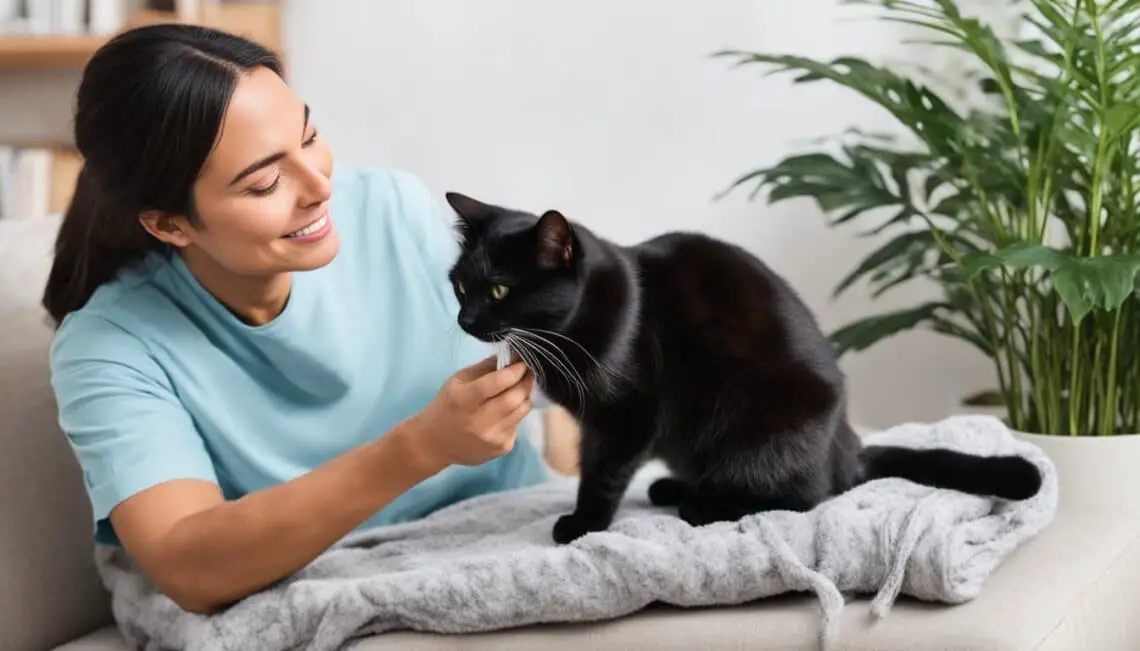Welcome to my blog, where I’ll be sharing tips and advice on how to strengthen the bond with your cat. As cat owners, we know how special these furry companions are, and building a strong relationship with them can be incredibly rewarding. Not only do cats provide us with love and companionship, but they also offer numerous benefits, such as lowering stress levels and enhancing our overall well-being. So, whether you’re a new cat owner or have had feline companions for years, these tips will help you foster a deeper connection with your beloved pet.
Ways to Bond With Your Cat
Grooming your cat regularly, if they enjoy it, can be a great way to spend time together. Not only does it help keep their coat healthy and reduce shedding, but it also provides an opportunity for bonding. Cats often enjoy the sensation of being groomed, and it allows them to feel cared for and loved.
Quality time is crucial for building a strong bond with your cat. This can include activities such as petting, snuggling, and playing. Pay attention to your cat’s preferences and engage in activities they enjoy. Some cats may prefer gentle petting and massages, while others may enjoy interactive play with toys or chasing a laser pointer.
Training cats is not as difficult as it may seem. Cats are intelligent animals and can learn a variety of commands and tricks. Training not only provides mental stimulation for your cat but also strengthens the bond between you. Start with simple commands like “sit” or “come” and use positive reinforcement, such as treats or praise, to reward their successful responses.
Leash training cats can be a unique and rewarding experience for both you and your feline friend. It allows them to explore the outdoors in a safe and controlled manner. Begin by introducing your cat to a harness and leash gradually, allowing them to adjust to the sensation. Once your cat is comfortable wearing the harness, start by walking them in a familiar and low-distraction environment. Remember to be patient and always prioritize your cat’s safety.
Meal-feeding your cat at specific times can create a strong association between you and mealtime. This ritual provides an opportunity for interaction and reinforces their bond with you as the provider of food. It also allows you to monitor their eating habits and ensures they receive the proper nutrition.
Remember, each cat is unique, so take the time to understand and cater to their individual preferences and needs. By grooming, spending quality time, training, leash training, and meal-feeding your cat, you can strengthen your bond and create a loving and fulfilling relationship.
| Ways to Bond With Your Cat | Benefits |
|---|---|
| Grooming | – Provides physical contact and relaxation – Helps maintain a healthy coat – Reduces shedding |
| Quality Time | – Builds trust and affection – Provides mental stimulation – Enhances overall well-being |
| Training | – Develops communication and understanding – Boosts mental agility – Deepens the bond |
| Leash Training | – Allows safe outdoor exploration – Stimulates the senses – Creates shared experiences |
| Meal-Feeding | – Fosters association and interaction – Promotes a healthy routine – Enhances the caregiver role |
Further Ways to Protect the Bond With Your Cat
In order to maintain a strong bond with your cat, it’s crucial to take steps to minimize stress and ensure their overall well-being. By addressing common issues such as inappropriate behavior and litter box problems, you can create a harmonious environment that fosters a deep connection. Additionally, monitoring your cat’s health and providing them with the necessary care will help keep them happy and thriving. Here are some further ways to protect the bond with your cat:
Reducing Stress for Cats
Cats are known to be sensitive creatures, and it’s important to create a calm and stress-free environment for them. Some simple ways to reduce stress include:
- Providing them with a quiet and comfortable space where they can retreat
- Using pheromone sprays or diffusers to create a calming atmosphere
- Establishing a consistent routine for feeding, playtime, and sleep
- Avoiding sudden changes in their environment or daily routine
Monitoring Cat Illnesses
Regular veterinary check-ups are essential for monitoring your cat’s health and catching any potential illnesses or conditions early on. During these visits, your vet will perform a thorough examination, check for signs of illness, and recommend any necessary vaccinations or preventive treatments. By staying proactive and attentive to your cat’s health, you can ensure they receive the care they need to stay happy and healthy.
Addressing Inappropriate Behavior
When it comes to addressing inappropriate behavior, it’s important to approach it with patience and understanding. Cats may exhibit behaviors such as scratching furniture or excessive meowing, which can be signs of frustration or anxiety. By providing them with appropriate outlets for their natural behaviors, like scratching posts and interactive toys, you can redirect their energy in a positive way. Additionally, positive reinforcement, such as treats and praise, can be effective in encouraging desired behavior.
Addressing Litter Box Problems
Litter box problems can be a source of stress for both cats and their owners. To address these issues:
- Ensure that the litter box is clean and easily accessible
- Use a litter that your cat prefers
- Consider providing multiple litter boxes, especially in multi-cat households
- Address any changes in the environment that may be causing stress or anxiety
By promptly addressing any litter box problems and making necessary changes, you can create a comfortable and stress-free space for your cat.
| Common Stressors | Ways to Minimize Stress |
|---|---|
| Moving to a new home | Gradual introduction to the new environment, providing familiar objects |
| Loud noises or sudden changes | Creating a quiet and calm space, using white noise machines or calming music |
| New additions to the household (such as another pet or baby) | Gradual introductions, ensuring each pet has their own space, and providing plenty of attention and affection |
| Lack of stimulation or environmental enrichment | Offering interactive toys, scratching posts, and providing opportunities for play and exploration |
Understanding Your Cat’s Communication and Body Language
When it comes to deciphering your cat’s behavior, understanding their communication and body language is key. Cats use a variety of gestures to express their needs, feelings, and intentions. By learning to interpret these cues, you can develop a deeper understanding of your feline friend.
One of the most common ways cats communicate is through rubbing against you. This behavior serves as a greeting and a way for them to deposit their scent, marking you as part of their territory. When your cat rubs against your legs or wraps their body around you, it’s a sign of affection and a desire to be close to you.
“Headbutting,” or bunting, is another form of communication that cats use. By gently bumping their head against you, cats are not only showing affection but also marking you as part of their territory. It’s a clear indication that they trust and feel comfortable with you.
Have you ever noticed your cat slow-blinking at you? Slow-blinking is a way for cats to convey contentment and trust. When your cat looks at you and slowly closes their eyes, it’s their way of saying, “I feel safe and relaxed around you.”
While many cats may expose their tummies as a sign of trust, most don’t enjoy belly rubs. When your cat rolls over and shows you their belly, it’s a vulnerable gesture that indicates they trust you. However, be cautious as petting their belly may make them feel exposed and uncomfortable.
Finally, one of the clearest indications that your cat trusts and likes you is when they choose to be close to you. Whether they curl up next to you on the couch or prefer to sleep near your feet, their proximity is a strong indicator of their bond with you.
By paying attention to these subtle cues and body language, you can develop a better understanding of your cat’s emotions and needs. Remember, every cat is unique, so take the time to observe your feline companion and build a stronger connection with them.
| Gesture | Meaning |
|---|---|
| Headbutting (Bunting) | Affection and marking territory |
| Slow-blinking | Comfort and trust |
| Tummy exposure | Trust (but most cats don’t enjoy belly rubs) |
| Choosing to be close to you | Clear sign of trust and liking |
Creating an Enriching Environment for Your Cat
When it comes to creating a bond with your cat, providing a cat-friendly environment is essential. Creating safe and warm spaces, offering sufficient resources, and catering to your cat’s natural behaviors are all key elements in fostering a strong connection. Understanding what your cat needs and providing outlets for their natural instincts will help create a happy and content feline companion.
Safe and Warm Spaces
Cats thrive in environments where they feel safe and secure. Creating cozy hiding spots, such as cat beds, blankets, or cozy corners with soft cushions, allows your cat to have a space of their own. These safe and warm spaces not only provide comfort but also give your cat a sense of security.
Sufficient Resources
In a multi-cat household, it’s essential to provide enough resources for each cat. Having multiple food and water stations, as well as litter boxes, ensures that each cat has their fair share. Furthermore, spacing these resources out throughout the house helps prevent territorial disputes between cats, reducing stress and creating a harmonious environment.
Catering to a Cat’s Nose
Cats have an exceptional sense of smell, and it’s important to consider this when creating an enriching environment. Avoid using strong-smelling cleaning products or air fresheners, as these can be overwhelming to cats. Additionally, allowing your cat to have items with their scent, such as blankets or toys, helps them feel more secure and comfortable in their surroundings.
Providing Outlets for Natural Behaviors
Cats have natural instincts and behaviors that need to be fulfilled to promote their well-being. Providing scratching posts or boards allows cats to engage in their natural scratching behavior, helping them keep their claws healthy and reducing the urge to scratch furniture. Vertical spaces, such as cat trees or shelves, cater to their instinct to climb and perch, providing them with a sense of territory and confidence. Interactive toys and play sessions satisfy their need for mental stimulation and exercise, further strengthening the bond between you and your cat.
By creating a cat-friendly environment that offers safe and warm spaces, sufficient resources, and opportunities to engage in their natural behaviors, you are providing your cat with the ideal setting for a happy and fulfilling life. This environment will not only enhance the bond between you and your cat but also contribute to their overall well-being and happiness.
Cat Bonding Tips for Better Understanding and Training
When it comes to bonding with your cat, it’s important to understand their preferences and respect their choices. Building a strong connection with your feline friend requires patience, empathy, and positive reinforcement. Here are some valuable tips to help you strengthen your bond and train your cat effectively:
- Observe their body language: Pay close attention to your cat’s body language. It’s their way of communicating with you. Notice their tail position, ear movements, and overall posture to understand their mood and needs.
- Let them initiate interactions: Cats value their personal space and independence. Allow them to approach you and initiate interactions. Respecting their boundaries shows that you respect their choices and helps build trust.
- Avoid punishment: Punishment can be counterproductive and damage your relationship with your cat. Instead, focus on positive reinforcement. Reward and praise your cat when they exhibit desired behaviors to encourage repetition.
- Use positive reinforcement: Positive reinforcement involves rewarding your cat for good behavior. This can be done through treats, praise, or playtime. By associating positive experiences with desired behaviors, your cat will be more motivated to repeat them.
- Training your cat: Contrary to popular belief, cats can be trained. Use positive reinforcement techniques to teach them commands, tricks, and basic behaviors. This not only strengthens your bond but also enhances communication and understanding between you and your cat.
Cat training and bonding require patience and consistency. Keep in mind that every cat is unique, so it’s essential to adapt your training methods to suit their individual personality and needs. By respecting their choices, offering positive reinforcement, and understanding their communication cues, you can build a strong and trusting relationship with your furry companion.
“Cat training and bonding require patience and consistency. Keep in mind that every cat is unique, so it’s essential to adapt your training methods to suit their individual personality and needs.”
Benefits of Positive Reinforcement Training
| Benefits | Description |
|---|---|
| Strengthened bond | Positive reinforcement training helps create trust and a stronger bond between you and your cat. |
| Promotes good behavior | By rewarding desired behaviors, you encourage your cat to engage in positive and appropriate actions. |
| Improved communication | Training enhances communication between you and your cat, allowing for better understanding of each other’s needs and preferences. |
| Reduced stress | Positive reinforcement training methods create a stress-free environment, reducing anxiety and promoting overall well-being. |
| Enhanced mental stimulation | Training engages your cat’s mind, providing mental stimulation and preventing boredom. |
Training your cat using positive reinforcement techniques is a rewarding experience for both of you. Remember to be patient, consistent, and understanding. By respecting your cat’s choices and boundaries, you can establish a deep bond and achieve successful training outcomes.
Bonding with Kittens
Bonding with kittens is a delightful journey that requires patience and understanding. As adorable as they are, kittens are still learning and adjusting to their new environment. By devoting time to observe their behaviors and preferences, you can foster a strong and loving bond.
Focused playtime is a wonderful way to interact with kittens and establish trust. Engage them with toys that encourage their natural instincts, such as feather wands or interactive puzzles. These activities not only strengthen the bond but also help kittens develop essential skills.
Appropriate petting is essential in building a positive connection with kittens. Gently stroke their backs and offer chin scratches, taking care to understand their individual comfort levels. Avoid overwhelming them and allow them to approach you for affection.
In addition to play and petting, training sessions can be a bonding experience for both you and the kitten. Begin with simple commands such as “sit” or “come,” using positive reinforcement like treats and praise. This creates a positive association and builds trust between you.
To create a safe and comforting space for kittens, ensure their environment is free from potential hazards. Set up a designated area with a warm bed, toys, and a litter box. Providing them with plenty of love, security, and a sense of belonging will help them adjust and feel safe in their new home.
FAQ
How can I bond with my cat?
Bonding with your cat is possible through grooming, quality time, training, and engaging in activities like going for walks and meal-feeding. Regular grooming, if your cat enjoys it, can be a great way to spend time together. Paying attention to quality time, such as petting, snuggling, and playing with your cat, helps build the bond. Training cats is possible and can strengthen the bond. Leash training your cat for walks or hikes can be a fun activity. Meal-feeding your cat at specific times allows for interaction and association with you.
How can I protect the bond with my cat?
To protect the bond with your cat, it’s important to limit stress in the home and be aware of any signs of illness or pain. Regular vet check-ups and parasite prevention are crucial for keeping your cat healthy. Providing ample scratching posts, exercise, and respecting their boundaries can help address inappropriate behavior. It’s also important to address any litter box problems promptly and make necessary changes to decrease stress.
How can I understand my cat’s communication and body language?
Cats communicate through various gestures and body language. They use rubbing against you as a greeting and a way to deposit their scent. Headbutting, or bunting, is a sign of affection and marking territory. Slow-blinking indicates comfort and trust. Cats may show their tummies as a sign of trust, but most don’t enjoy belly rubs. Choosing to be close to you is a clear sign of trust and liking.
How can I create an enriching environment for my cat?
Creating an enriching environment for your cat includes providing safe, warm spaces and plenty of hiding spots. Having multiple, well-spaced resources like food, water, and litter boxes is important, especially in multi-cat households. Catering to a cat’s sensitive nose by not using strong smells and allowing them to have items with their scent on them is crucial. Satisfying a cat’s natural behaviors through scratching, climbing, jumping, and interactive play helps bond with your cat.
What are some tips for better understanding and training my cat?
Bonding with your cat is about understanding their preferences and respecting their choices. Pay attention to their body language and let them decide when to interact and when to retreat. Avoid punishment and use positive reinforcement to encourage desirable behaviors. Training your cat can strengthen the bond and improve communication.
How can I bond with kittens?
Bonding with kittens requires patience and adjusting expectations. Spend time observing their behaviors and preferences. Focused playtime, appropriate petting, and training can help strengthen the bond. Providing a safe and comforting space for kittens to adjust to their new home is crucial.







No Comments